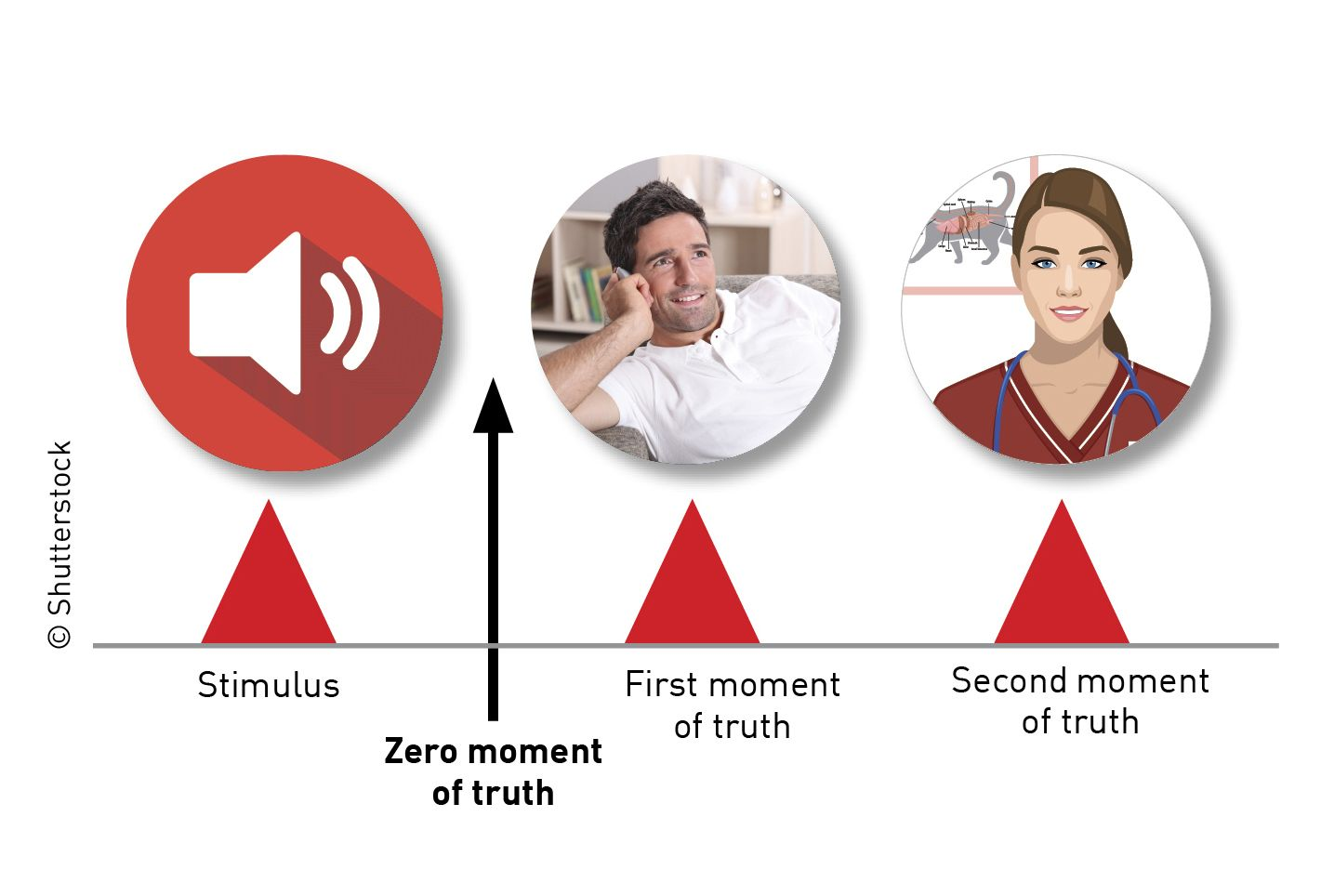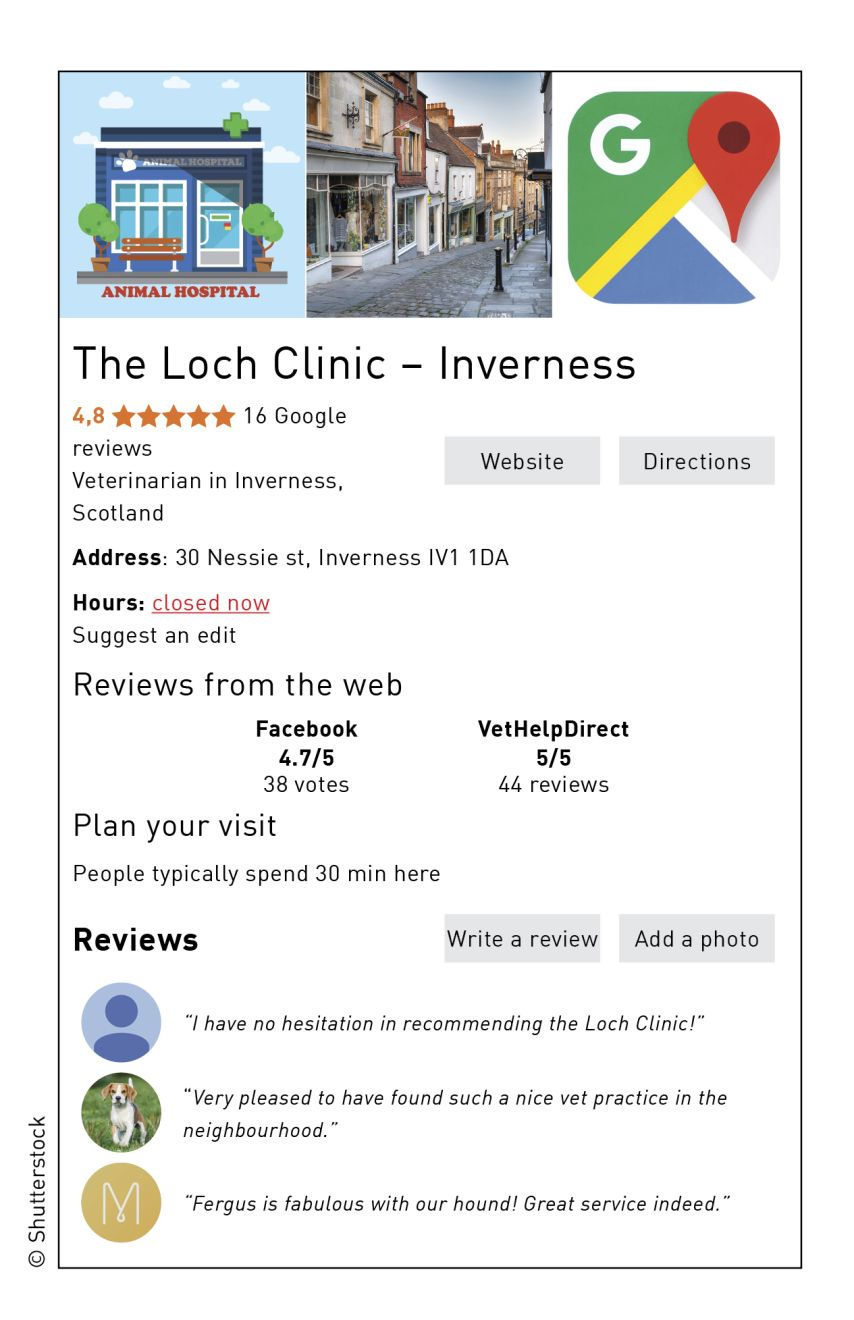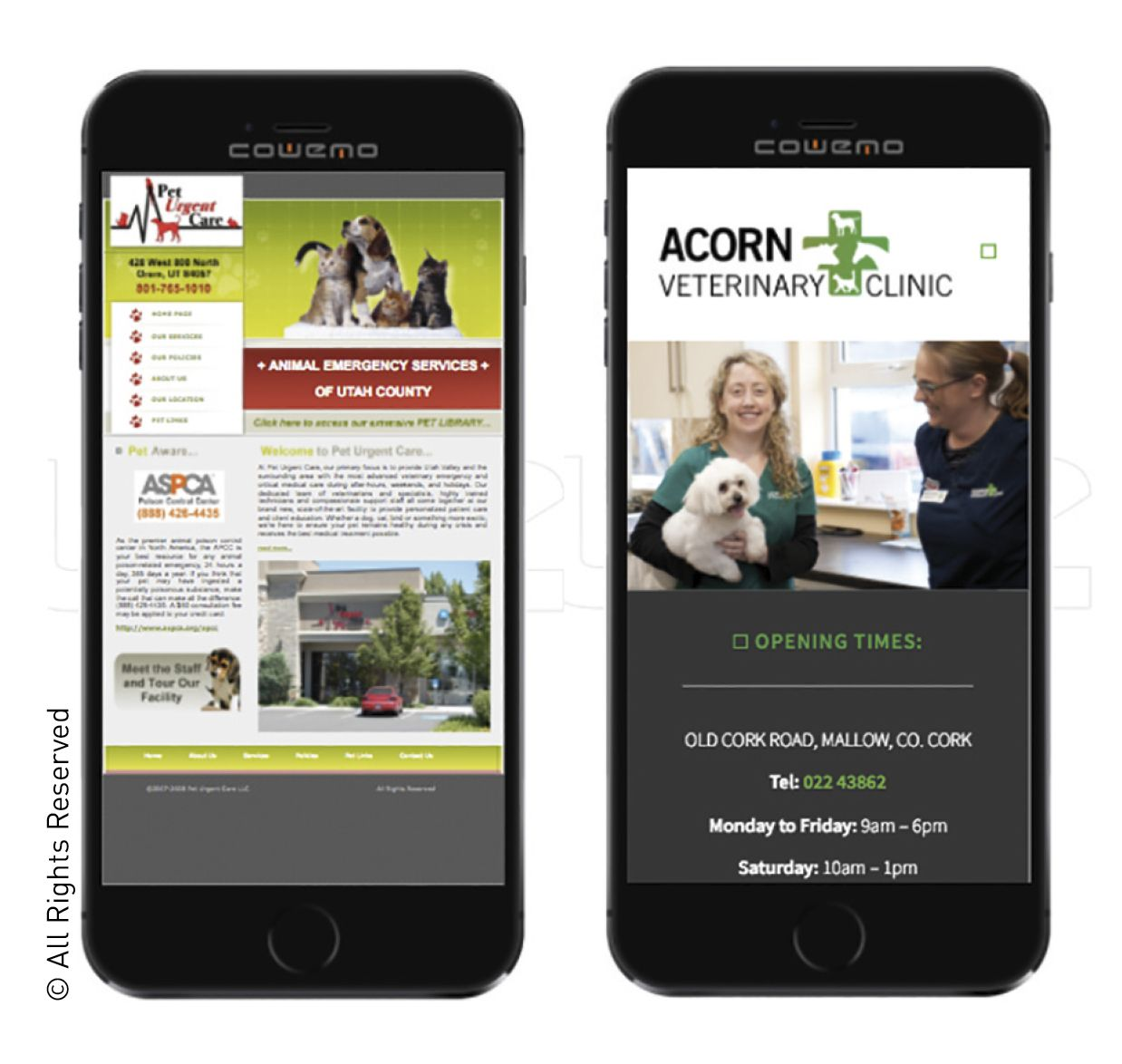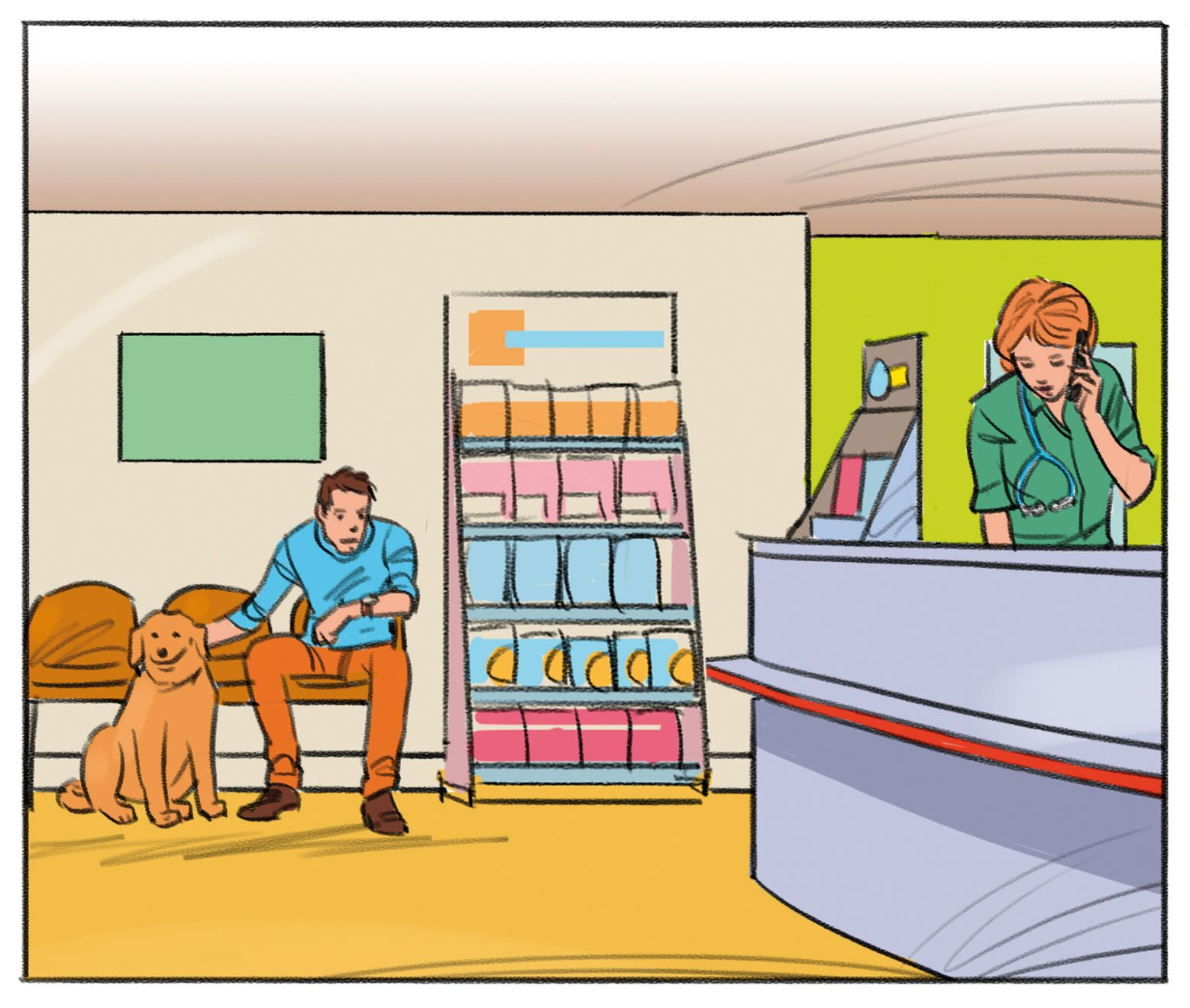How to attract clients to your clinic
Written by Philippe Baralon , Antje Blättner, Pere Mercader and Susie Samuel
Internet has changed the “pet owner journey”: before telephoning a vet to ask questions or actually taking an appointment, the client will search the Internet (sometimes just to find a telephone number) and will have first information about your practice through it. Will there be reviews about your practice? Can one easily find practical information on your website? What is the look and feel of your Facebook page? Unlike some years ago, pet owner will start forming an opinion about you long before contacting your staff. This chapter will give you the basics on how to improve your digital presence as well as your telephone skills.
© Shutterstock

Key points
Vets should be proactive regarding reviews on the Internet, asking clients to post positive feedback online.
It is worth considering investing in Google and Facebook Ads
Every phone call should have a clear goal: a visit to the practice
Zero moment of truth
How do pet owners choose a vet? In 2011, Google came up with the term “Zero Moment of Truth (ZMOT)” following research it undertook with Shopper Science to discover more about peoples’ shopping habits [1]. The traditional marketing model prior to this was a model of a Stimulus, when the shopper saw an advert for a product, the First Moment of Truth when the shopper saw the product on the shelf and decided to purchase it, and the Second Moment of Truth when the product was used and the shopper experienced it. If marketers could get those three stages right then they would be able to sell their products. The research from Google showed that there is now an extra stage in this model that Google terms “The Zero Moments of Truth” or ZMOT. The ZMOT is when shoppers go online to compare products, look at reviews, watch videos and read blogs; the research showed that this is now a highly relevant and important stage in client decision-making. Figure 1 shows the illustration of this model in the context of an owner looking for a vet.
Research from VetHelpDirect and Onswitch in 2015 (Figure 2) was undertaken to establish if the ZMOT existed for pet owners looking for a vet in the UK, and if it did exactly what online activities it incorporated: 309 pet owners were asked “If you had to choose a vet now which of the following would you do?” They were given the following options: Google, look at online reviews, view the practice website, visit the Facebook page, look at practice leaflets, walk into the vet practice, ring the vet practice up, ask friends and ask Local Pet Experts. The most popular response was “Ask Friends” reflecting the continued importance of word-of-mouth recommendations as a source of referrals of new clients. The next two most popular actions were online, including look at online reviews and visit the practice website. Ask local pet experts came next followed by googling the practice. Walking into the vet practice, telephoning the practice and looking at practice leaflets all ranked below the online activities in importance. This survey provides clear evidence that an online Zero Moment of Truth plays an important role when pet owners are choosing a vet.

The VetHelpDirect, Onswitch survey showed that looking at online reviews was the most commonly undertaken online activity; 49.7% of owners surveyed said that they would look at online reviews prior to choosing a vet. This importance of online reviews is backed up by statistics from Ofcom in the UK who tell us that three-quarters of Internet users (78%) read reviews. Reviews can have a positive impact on business, research from Revoo shows us that reviews typically generate an 18% increase in sales [2]. This research highlights the importance of reviews for veterinary practices and the potential positive effects. It is interesting to note that reviews seem to be more important to pet owners looking for a new vet than either the practice website, Facebook page or leaflets. In the author’s experience veterinary practices tend not to invest time or budget in creating and maintaining current and comprehensive set of online reviews, this is in contrast to the investments made in the website, Facebook page and practice leaflets.
Pet owners access online reviews by googling “[Practice name] review” by searching for a vet in the area, or on the practice website if an appropriate widget is used to display the reviews. By displaying reviews on practice website, veterinary practices can benefit from a larger audience of potential new clients seeing the reviews (Figure 3).
Reviews have also been shown to assist with Search Engine Optimisation (SEO), that is the position of the practice website in the Google search results [3], Moz found that review quantity, velocity and diversity are all factors that govern the position of local businesses in the Google search pack.
It is essential for veterinary practices to be proactive about building up reviews, if practices do nothing they risk a negative and unfair reflection of the veterinary practice reputation appearing online. Unless veterinary practices regularly ask clients to leave a review only the very passionate owners will think of doing so. Some of these owners will be passionately positive, perhaps the vet has gone above and beyond what was necessary to look after their pet, but unfortunately the passionately unhappy clients tend to be overrepresented. Angry clients are more likely that those that have had a good, ordinary experience to go to the trouble finding a review platform leaving a review.
Ofcom tell us that whilst over three quarters of UK Internet read reviews only four in 10 have ever written one [4], getting these clients that have had ordinary, happy experiences to leave a review can be a challenge. Sending out regular emails inviting all clients that have been seen that week or month to leave a review is one of the most effective ways of getting clients to review the practice, training the whole practice team to ask people to leave a review can help, as can having a tablet in reception that allows people to leave an online review whilst they wait. This is also a great opportunity to collect feedback on the client experience in the practice. The client experience, rather than the clinical excellence of the vets tends to determine how good clients will deem the practice to be, so improving this is an essential part of building up a good set of online reviews. Once a practice has a good set of reviews that is regularly updated, negative reviews become far less damaging, viewers can see that these are not the norm and can readily put them into context.

Website and social media
The VetHelpDirect Onswitch survey of pet owners showed that, after reading word-of-mouth recommendations and online reviews, looking at the practice website and Facebook page were the next most important activities that pet owners would undertake if they were looking for a new vet.The practice website can provide a “brochure-type” experience, comprehensively covering full details of the practice as well as providing an educational resource for clients or potential new clients. The Facebook page is more informal and allows the practice to profile the warm, caring relationship that they have with their clients, it is also possible to reach out and build relationships with local owners that are not clients.
Website
The practice website has several functions; it must entice potential new clients to choose the practice, contain information about the practice, e.g., staff, facilities, provide a relevant and useful educational resource and become a hub making it easy to access the various social media platforms the practice uses. The website may also contain functionality for clients to book appointments, order food, repeat prescriptions etc. Research shows that 55% of website users spend less than 15 seconds on a website before leaving if they consider it is unsuitable for them. The challenge for vet practices is to convey the essence of the practice in that very short period of time. Photography, video and excellent copywriting is the key to succeeding with this.

Telephone number and address should be clearly presented on each page, the telephone number should be “click to call” format so that on mobile phones people can call simply by touching the number.
Many veterinary practices offer online appointment booking so that clients can book an appointment at a time that suits them. Not only is this more convenient for clients, clients who prefer to book appointments online may choose a practice that offers this over one that does not, particularly if it is late at night and they want to complete the task of getting an appointment arranged.
Displaying reviews on the website homepage offers “social proof” to the user, as discussed in the “Zero Moment Of Truth” chapter, reviews have been shown by many studies to increase the conversion rate, by putting these reviews in a highly visible place on the website homepage the number of potential clients seeing those reviews will be increased.
Having prominent links to social media is useful so that clients can find the platforms readily. Facebook “Like boxes” or other feeds are also recommended as they bring some of the life and energy of the Facebook page to the website as well as offering more “social proof” to potential new clients.
Facebook page
Used correctly the Facebook page can be a powerful method of new client acquisition (Figure 5). Every time a client engages with the practice Facebook page some of their friends will see that interaction and in doing so be exposed to the brand of the practice. Not only does this create an indirect word-of-mouth recommendation, through the knowledge that their friend uses this veterinary practice and seeing evidence of a happy relationship with it, it also creates the opportunity for the friend to like the Facebook page thus creating a permanent connection with the practice. Relationships can be built up with local pet owners, giving them an opportunity to get to know the practice over time.

It can be tempting to exclusively write posts that promote the advantages of the practice or offers that are running in practice, however Facebook tends to work far better when practices focus on talking about what the community want to talk. Profiling stories about recent cases seen at the clinic, photos of pets in the waiting room, stories and images of staff at work tend to work well. Social media works best as a two-way conversation so open posts work better than closed statements. As with all conversations it is essential to reply to comments and questions, or at least to “Like” them, tools such as the Facebook Pages app for mobiles are very helpful with this. For optimal results practices should aim to post every 4 hours during the day to reach the maximum number of people. Tools such as Facebook scheduling makes regular posting achievable even for small practices, it means practices can write posts in advance and schedule them for specified days and times; posts can be written when things are quiet and scheduled for regular updates during the month. We recommend using a combination of scheduling and posting on an ad hoc basis when suitable moments arise. Setting up a private group for members of staff to privately share content also helps, this means every member of the team including new or inexperienced members of staff can share content they come across that they think would work on the page. The administrator then simply works their way through the posts shared to the group and can schedule all appropriate content to the practice page. Using these methods most practices can achieve at least once a day posting with many small practices in the UK managing to post at least 4 times a day, thus maximising the number of people that will see their content. Outsourcing to specialist agencies is increasingly common, giving the Facebook page a lift by bringing in specialist skills as well as assistance with post volume.
On Facebook, it is essential to reply to comments and questions, or at least to “Like“ them.
Facebook ads are now an essential part of running a successful Facebook page. When a Facebook user logs on to their Facebook feed there are, on average, 1500 posts from their friends, or from pages that they follow that they could see. The Facebook algorithm prioritises content that is most recent and interesting to that user based on their previous behaviour. This Facebook algorithm also prioritises posts from people over pages, which means that to get the most from their Facebook pages businesses must invest in Facebook Ads. Facebook ads can be targeted to be shown to local pet owners, different ads should be made for dog owners and cat owners to make them as relevant as possible. Facebook ads run on a budget, once this budget is used up the adverts stop running.
| Ads for likes | Designed to get more relevant people to like the Facebook page |
| Ads for engagement | Designed to ensure that more people see the content from the page |
| Boosts | Can be run on an ad hoc basis to promote individual posts that are important to the practice |
It is possible to run a “boost” for an individual post and this can be useful however better results are usually obtained by running an ad campaign from ad manager.
| Minimum budget stipulated by Facebook | €34/month |
| Budget range of independent practices | €34–€136/month |
| Average number of new page likes/€ | 2 |
| Average paid reach*/€ | 140 |
*Paid Reach = number of people that see posts from the practices due to ads
Other social platforms can be useful for veterinary practices, in particular Instagram is being used very successfully by some UK practices. Twitter, LinkedIn and Google+ are used by some but for most first opinion practices Facebook delivers far better results for the time invested.
Search
For an average page of Google results over 30% of people will click on the first result and less than 2% on the last result. When you consider that for a small town in the UK we would expect approximately 800 searches for the search term “Vets in [town]”, it becomes clear that 240 potential new clients could be missed by not occupying the first position. The Google search engine result is often the first piece of information that a client will see about the practice so it is important that the result is well written and enticing for potential new clients to click on.
Google uses a combination of factors to decide which practices will be displayed top in the search results, by working on improving these factors it is possible to improve the practice’s position in the search results. This approach takes time and is a long-term strategy, however the prize of ranking top in the Google search results has a huge value. A short-term fix is to use Google Adwords to pay to ensure the practice is shown in the top few places. Google Adwords works by setting a budget, when users click on the ad Google is paid from the budget, when the daily budget is used up Google stops showing the ad. As with Facebook Ads, Google ads should be targeted so that they are only shown to users that are looking for a vet in the relevant area.
Factors in the Google Local Algorithm and how to improve them
- Claim your listing (Search “Google My Business” for more information)
- Check all information is accurate
- Keep the listing up-to-date with photos and information such as opening times
- Use the new functionality to post updates to the practice Google My Business profile
Website
- Ensure this is mobile-optimised
- Check that a site map is present
- Ensure your telephone number and address is present as text rather than an image
Review volume, velocity and diversity
- Build up reviews on Google as well as a variety of other review platforms
- Ensure that reviews are continually being added to
Citations (mentions of name, address and telephone)
- Build up as many of these as possible on directories around the Internet and on the websites of local partners
Links to your website
- Build up as many of these as possible using directories and asking local businesses to link to your website, in return for a link from you to their website
The phone call — first important contact
The telephone is a wonderful opportunity to make a positive first impression during the initial contact with a client, creating a bonus in terms of service and acting as the first step in creating loyalty — and it comes after several other forms of contact: digital (website, Facebook, Instagram etc.) and word of mouth on the dog runs and among friends and relatives. Since all messages prior to the first contact are a mixture of experience, rumours and subjective points of view, it is so important to be friendly, pleasant and 100% client-oriented in the first call with a pet owner (Box 1).
|
Receptionist: ABC Veterinary Practice, Anne Roberts speaking, how may I help you? Receptionist: We will send the leaflet today and are looking forward to your visit with Kitty. Please remember to give us a call, if you can´t make it. |
Set guidelines
At some practices the term “client-oriented” is confused with “I sit and listen to the pet owners for hours”. However, every phone-call needs to have one clear goal in mind: a visit to the practice with a consultation, comprehensive physical exam and additional services, as they form our core business. Free advice (particularly for non-clients) is not just a waste of time, but is also harmful as it takes time away from the pet owners who are in the practice and are already clients.
Thus, a client-oriented, empathetic phone call will strike an optimal balance between the client’s needs and desires and the limits that are in place at the practice (time, staff, etc.). To create this balance and to ensure every client receives the same level of service, a general structure for all phone calls is advisable!
The basic structure for a professional phone call in the day-to-day practice routine may contain the following points:
- Greeting: introduction, obtaining the client´s and the pet´s data (client name, pet name, species, age, gender and breed).
- Main part: discovering the clients´ needs and wishes, getting feedback to confirm the needs were understood correctly, offering an appointment.
- Ending: repeating and summarising the agreements, taking down notes in the client´s file or in a special folder created for new clients in the practice computer system.

Not too little but not too much either!
Employees should be able to react flexibly to the needs of the clients while avoiding talking too long and gathering too much information, the phone is definitely the wrong tool to collect a detailed medical history. The history taking is a core part of any consultation and needs to take place in the practice face-to-face with the practice team and the vet. On the phone, misunderstandings that can lead to conflicts are more easily created and discussing symptoms with clients takes up too much precious time! On the phone you need to focus on getting the client to come to the office to deliver high-quality medical care:
- Record as much information as needed
- Be empathetic and offer an appointment in the practice
Dedicated phone staff
The most common “complaints” from clients about phone service usually focus around perceived unfriendliness.
Here is what you should keep in mind to facilitate good telephone service (Box 2):
- Be careful when hiring employees: slightly extroverted persons who like to communicate with people make good reception staff. Restraining talented communicators who go too far, e.g., spend way too much time on the phone is much easier than dealing with people who generally do not want to be in the spotlight.
- Train employees: (at first) trainees are unsuited for taking on important telephone responsibilities! New employees should be trained for this important job in several phases. Here written guidelines and role-playing games under the supervision of experienced staff are useful instruments.
- Optimise the surroundings: even the best phone pro can experience massive stress when they are alone at the reception with two ringing telephones plus managing incoming and outgoing clients! (Figure 7).
| 💡 Additional tips for ensuring good performance and good service |
|

Champions league on the phone
What does a “top-telephone” call look like, which wins over clients and makes them 100% positive about the upcoming visit? One important factor is training practice employees properly to be flexible with clients and make suitable suggestions. However, the most important factor is having an employee who can connect immediately with clients, by skilfully and empathetically listening to the client and reading the signals clients send out and using the gathered information in the conversation. The client then feels accepted, respected and validated. After the call the collected data needs to be placed in the practice software, so that all employees have access to the information to be able to greet Mrs Green professionally and immediately establish a connection.
Conclusion
A good website requires generally the help of a company specialised in this area. A Facebook page can be easily managed by a nurse providing you establish some rules. Finally, the most critical part in the communication prior to the visit is the phone call. It is where clients can be won or lost. In big practice, the trend is to disconnect the call centre from the front desk for a better quality of service.References
- Winning the Zero Moment of Truth, Jim Lecinski 2011:https://www.thinkwithgoogle.com/future-of-marketing/emerging-technology/2011-winning-zmot-ebook/
- Moz 2017 Local Search Ranking Factorshttps://moz.com/local-search-ranking-factors
- Ofcom 2016https://www.ofcom.org.uk/__data/assets/pdf_file/0026/80828/2016-adults-media-use-and-attitudes.pdf
- Tony Haile, Chartbeat 2014https://time.com/12933/what-you-think-you-know-about-the-web-is-wrong/
Philippe Baralon
DVM, MBA
Dr. Baralon graduated from the École Nationale Vétérinaire of Toulouse, France in 1984 and went on to study Economics (Master of Economics, Toulouse, 1985) and Business Administration (MBA, HEC-Paris 1990). He founded his own consulting group, Phylum, in 1990 and remains one of its partners to this day, acting primarily as a management consultant for veterinary practices in 30 countries worldwide. His main areas of specialization are strategy, marketing and finance, and he is also involved in training veterinarians and support staff in the field of practice management through lectures and workshop, as well as benchmarking the economics of veterinary medicine in different parts of the world. A prolific author, he has authored more than 50 articles on veterinary practice management.
Antje Blättner
DVM
Dr. Blaettner grew up in South Africa and Germany and graduated in 1988 after studying Veterinary Medicine in Berlin and Munich. She started and ran her own small animal practice before undertaking postgraduate training and coaching course at the University of Linz, Austria and then founded “Vetkom”. The company provides training to veterinarians and veterinary nurses in practice management in subjects such as customer communication, marketing and other management topics. Dr. Blaettner also is editor for two professional journals, “Teamkonkret” (for veterinary nurses) and “Veterinärspiegel” (for veterinarians).
Pere Mercader
DVM, MBA
Dr. Mercader established himself as a practice management consultant to veterinary clinics in 2001 and since then has developed this role in Spain, Portugal and some Latin-American countries. His main accomplishments include authoring profitability and pricing research studies involving Spanish veterinary clinics, lecturing on practice management in more than 30 countries, and authoring the textbook “Management Solutions for Veterinary Practices” which is published in Spanish, English and Chinese and has sold worldwide. In 2008, he co-founded VMS (Veterinary Management Studies), a business intelligence firm that provides a benchmarking service for more than 800 Spanish veterinary practices. Dr. Mercader was also a co-founder of the Spanish Veterinary Practice Management Association (AGESVET) and served on its board for eight years.
Susie Samuel
MA, VetMB, MRCVS
Dr. Samuel graduated from Cambridge University in 2001 and spent ten years working in both mixed and small animal practices. In 2006 she set up VetHelpDirect.com, a website that helps owners decide how quickly they need to seek veterinary attention for their pets. The business quickly evolved to become a specialist veterinary Internet marketing agency, winning the 2015 Veterinary Marketing Award for Practice Marketing, and Dr. Samuel eventually left practice to become managing director of the company. She also holds the Google Certificate in Internet Marketing, and trains veterinary staff in all aspects of Internet marketing.
Other articles in this issue
Share on social media